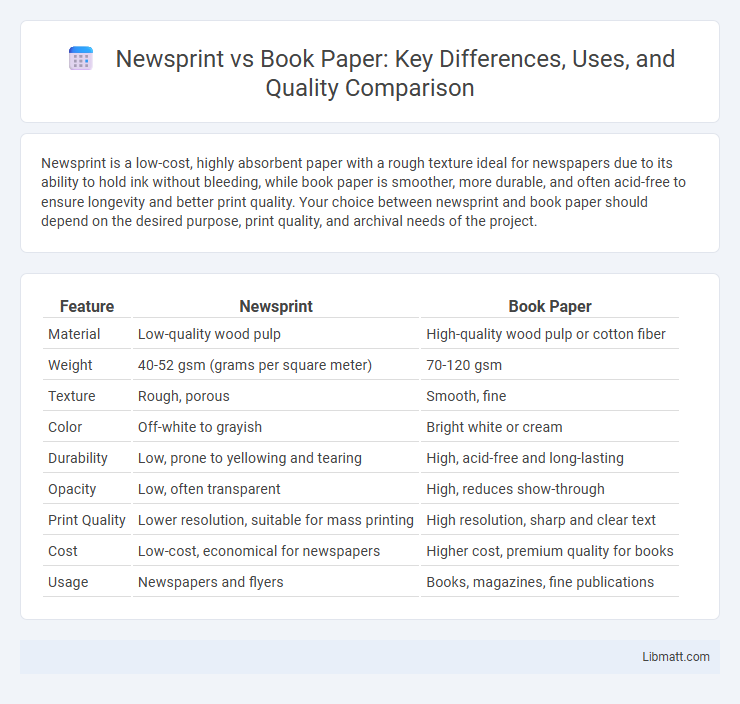Newsprint is a low-cost, highly absorbent paper with a rough texture ideal for newspapers due to its ability to hold ink without bleeding, while book paper is smoother, more durable, and often acid-free to ensure longevity and better print quality. Your choice between newsprint and book paper should depend on the desired purpose, print quality, and archival needs of the project.
Table of Comparison
| Feature | Newsprint | Book Paper |
|---|---|---|
| Material | Low-quality wood pulp | High-quality wood pulp or cotton fiber |
| Weight | 40-52 gsm (grams per square meter) | 70-120 gsm |
| Texture | Rough, porous | Smooth, fine |
| Color | Off-white to grayish | Bright white or cream |
| Durability | Low, prone to yellowing and tearing | High, acid-free and long-lasting |
| Opacity | Low, often transparent | High, reduces show-through |
| Print Quality | Lower resolution, suitable for mass printing | High resolution, sharp and clear text |
| Cost | Low-cost, economical for newspapers | Higher cost, premium quality for books |
| Usage | Newspapers and flyers | Books, magazines, fine publications |
Introduction to Newsprint and Book Paper
Newsprint is a low-cost, non-archival paper primarily used for printing newspapers, characterized by its lightweight, rough texture, and high wood pulp content, which leads to quicker yellowing and deterioration over time. Book paper is a higher-quality, smoother, and more durable paper often made from bleached wood pulp or cotton fibers, designed to withstand frequent handling and maintain readability, commonly used for novels and academic texts. The fundamental difference lies in their manufacturing process and intended use: newsprint prioritizes cost-efficiency and rapid production, while book paper emphasizes longevity and print clarity.
Key Differences Between Newsprint and Book Paper
Newsprint is a low-cost, lightweight paper primarily used for newspapers, made from mechanical pulp that yields a rough texture and lower durability, whereas book paper is produced from higher-quality chemical pulp, resulting in a smoother surface and enhanced longevity suitable for printed books. Newsprint typically has a higher opacity but yellows quickly due to its acidic content, while book paper is acid-free, offering better color reproduction and resistance to aging. Understanding these distinctions helps you select the appropriate paper for print projects requiring durability and visual clarity.
Composition and Material Properties
Newsprint is primarily composed of low-cost recycled fibers and mechanical pulp, resulting in a lightweight, highly absorbent material with a short lifespan and lower brightness. Book paper, in contrast, utilizes higher-quality chemical pulp with added fillers and coatings to enhance durability, opacity, and color retention, making it more suitable for long-term use and high-resolution printing. Your choice between newsprint and book paper should consider these composition and material properties to meet the desired print quality and longevity.
Printing Quality and Readability
Newsprint offers lower printing quality with less sharp images and text due to its coarse, high-absorbency fibers, making it less suitable for detailed graphics and fine typography. Book paper features smoother, denser fibers that enhance ink adhesion and color reproduction, resulting in crisp text and vibrant illustrations, thereby improving overall readability. The higher brightness and opacity of book paper reduce bleed-through and eye strain, making it the preferred choice for prolonged reading experiences.
Cost Comparison: Newsprint vs Book Paper
Newsprint is significantly more cost-effective than book paper due to its lower quality, faster production process, and use of cheaper recycled fibers. Book paper involves higher manufacturing costs because of its superior brightness, durability, and acid-free composition, which ensures longevity and print clarity. This cost difference makes newsprint ideal for mass-distribution materials like newspapers, while book paper suits premium publications requiring lasting quality.
Durability and Longevity
Newsprint is made from inexpensive wood pulp, resulting in lower durability and a high tendency to yellow and become brittle over time. Book paper, often acid-free and made with higher-quality fibers, offers superior longevity and resistance to deterioration, making it ideal for preserving your printed materials. Investing in book paper ensures your documents maintain their integrity and readability for decades.
Environmental Impact and Sustainability
Newsprint, made from lower-quality recycled fibers, has a higher environmental impact due to its shorter lifespan and frequent disposal, contributing to increased waste. Book paper, often produced from higher-quality, sustainably sourced materials and sometimes certified by environmental organizations like FSC, supports longer use and better recyclability. Your choice of book paper over newsprint can promote sustainability by reducing deforestation and encouraging the use of eco-friendly production practices.
Common Uses and Applications
Newsprint is primarily used for printing newspapers, flyers, and other short-lived publications due to its low cost and lightweight qualities. Book paper, characterized by higher durability and smoother texture, is commonly utilized for novels, textbooks, and archival materials requiring longevity and a superior reading experience. The distinct applications arise from the differences in paper weight, brightness, and print quality tailored to each medium's purpose.
Technological Advances in Paper Production
Technological advances in paper production have significantly improved both newsprint and book paper quality, enabling higher durability and print clarity. Newsprint is now produced with enhanced pulp treatments and faster drying techniques, allowing for cost-efficient mass printing with reduced ink smudging. Your choice between these papers benefits from innovations like lignin removal and chemical bleaching, which provide book paper with superior whiteness and longevity ideal for archival purposes.
Choosing the Right Paper for Your Project
Selecting the right paper for your project depends on the intended use and durability requirements. Newsprint is an inexpensive, lightweight option ideal for short-term publications like newspapers, offering high absorbency but low longevity and brightness. Book paper features higher opacity and smoother texture, providing enhanced durability and print quality suitable for long-lasting publications such as novels and reference materials.
Newsprint vs book paper Infographic

 libmatt.com
libmatt.com